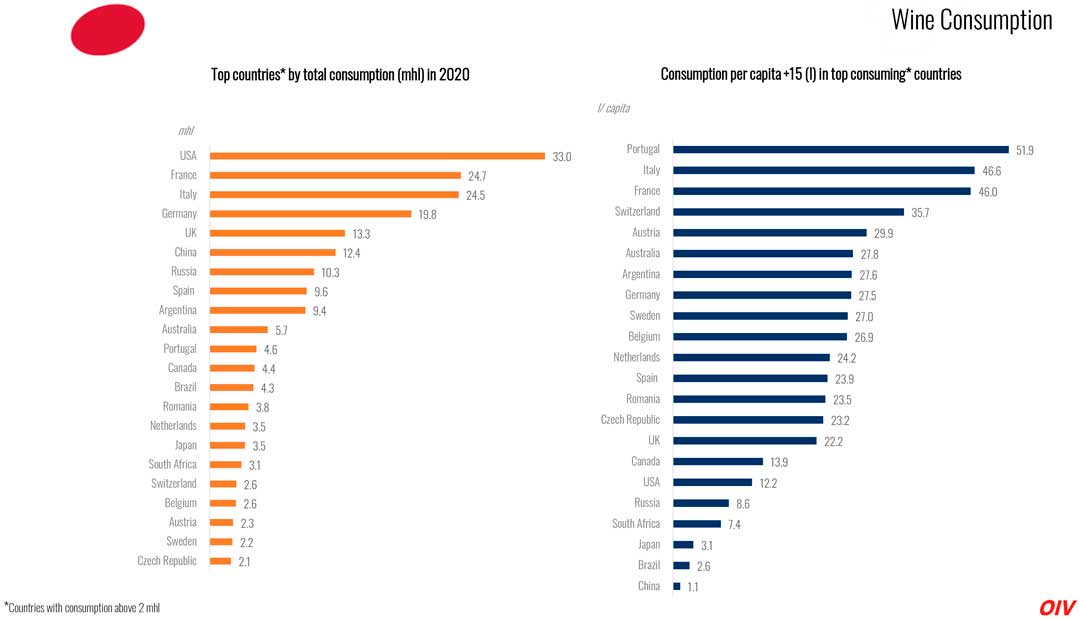Per capita wine consumption
Big countries drink a lot of wine, but which nations are the most enthusiastic wine drinkers? In other words: how much wine is consumed in a country per person. In the previous article, I looked at total wine consumption; here, I will dive into the statistics on wine consumption per capita.
The most enthusiastic wine drinkers are traditional wine-producing countries. France and Italy are high up on the list of drinking the most wine per person. But the number one spot, drinking most wine per person, is taken by Portugal, with 52 litres of wine per person and year. The numbers also reveal that there are some wine-producing countries that seem not to like their own products very much, drinking little of it. And other countries making no wine but that drink lots of it. Read on!
Read all our articles in the Wine Global 2020 series here:
- Global wine production 2020
- The World’s vineyard surface 2020
- How important is wine production to a country?
- The world’s most productive wine producing countries
- World wine consumption in 2020
- Wine consumption per person in 2020
- World wine exports in 2020
- World wine imports in 2020
- Wine exports compared to total production (dependency on exports)
- Wine exports compared to GDP and to total exports
- Average price per litre on export, by country
- Exports in bottle, sparkling, bag-in-box, bulk in 2020
Data comes from the OIV, the International Organisation of Vine and Wine, unless otherwise noted.
The world wine consumption per capita amounts to 3.3 litres per person (260 Mhl and 7.9 billion people). Statista estimates 74% of the world population to be 15 years old or more. This then gives a world per person consumption of 4.4 litres per capita, 15 years or older. (The 15-year limit is used in the below numbers.)
World wine consumption:
3.3 litres per person
or 4.4 litres per over-15
The biggest wine lovers in 2020
Counting wine consumption per capita, the three most enthusiastic wine drinkers are:
- Portugal, 51.9 litres of wine per year
- Italy, 46.6 litres
- France, 46 litres
The numbers concern consumption per capita, counting people over 15 years of age, litres per person. Only countries whose total consumption exceeds 2 Mhl are included.
Top per capita wine consuming countries in 2020
| Rank | Country | consumption per person, litre wine |
|---|---|---|
| 1 | Portugal | 51.9 |
| 2 | Italy | 46.6 |
| 3 | France | 46 |
| 4 | Switzerland | 35.7 |
| 5 | Austria | 29.9 |
| 6 | Australia | 27.8 |
| 7 | Argentina | 27.6 |
| 8 | Germany | 27.5 |
| 9 | Sweden | 27 |
| 10 | Netherlands | 24.2 |
| 11 | Spain | 23.9 |
| 12 | Romania | 23.5 |
| 13 | Czech Republic | 23.2 |
| 14 | UK | 22.2 |
| 15 | Canada | 13.9 |
| 16 | USA | 12.2 |
| 17 | Russia | 8.6 |
| 18 | South Africa | 7.4 |
| 19 | Japan | 3.1 |
| 20 | Brazil | 2.6 |
| 21 | China | 1.1 |
The cut-off of 2 Mhl total consumption eliminates a number of countries that otherwise sometimes appear in this kind of rankings (Luxemburg, Sao Tome and Principe, Vatican State, Andorra…) and are often pointed out as “surprising” on those rankings. It can make much sense to exclude these, although it also excludes some bigger countries (Serbia, Moldova, Georgia…). More on this further down in the article.
Portugal is a long-time champion of this league. Italy and France, the two biggest wine producers, are also at the top, although they have reduced the consumption radically over the second half of the last century.
A few things that are worth noting in this ranking:
Wine lovers but not wine producers
Sweden, the Netherlands, the UK and Japan drinks a lot of wine but does not make (much of) it.
Sweden is in 9th position. It is the first country in the ranking that does not have a significant wine production (although there are maybe around one hundred hectares of vines today). Total alcohol consumption has declined slightly in recent years but has grown significantly over a longer time period, in spite of the monopoly whose sole purpose is to reduce consumption. Wine has seen a steady upwards trend. Wine has been very successful in Sweden. (BKWine Magazine – bilingual English/Swedish, and one of the few Swedish publications with in-depth wine coverage – claims no credit for that. At least not too much.)
There are three other countries on the list without a significant wine production: the Netherlands, the UK, Japan.
What’s going on in Spain?
Wine seems to be having a tough time in Spain. Portugal, its neighbour, is the biggest drinker of wine per capita. Spain is the third biggest wine producer, after Italy and France. Both France and Italy are serious wine drinkers. But Spain is in 11th place in this ranking, after both Sweden and the Netherlands!
Have the Spaniards fallen out of love with wine? Is Spain in urgent need of a domestic campaign to make wine popular again?
Wine producers who don’t like the wine…?
Five of the worlds biggish wine producers (in the top 19) are – remarkably – missing in the list of consumption per capita (adding to the sad situation with Spain, just mentioned):
- Chile
- New Zealand
- Hungary
- Greece
Georgia(see below)
They make wine but don’t drink much of it. Why?
Most notable is perhaps Chile, since its neighbour, Argentina, is well-placed in 7th position. Chile has a population of 19 million but doesn’t even manage to come up to the 2 Mhl cut-off mark of total consumption. But it is a well-known (regrettable) fact that Chileans are not big wine drinkers, whereas Argentineans cherish their wine. Many Argentinean wine bottles even say “bebida national” (national drink) on the label. And both are big consumers of asado, the local speciality of grilled meat that goes so well with wine. Maybe this will be a cause for concern if wine exports get a hit. Chile exports a lot of wine and has had great success in China. But China is a fickle market, and the situation can change rapidly. See more on exports in the future article.
The other four countries are relatively small countries: New Zealand 5 million in population, Hungary 10 mil, Greece 11 mil., and Georgia 11 mil (correction:) 3.7 million. Maybe the small size means that they don’t make the 2 Mhl total consumption cut-off?
On the other hand, there are several countries – some non-wine producing countries too – of similar size that do appear on the list: Austria, Switzerland, Sweden, and the Czech Republic. I’d say there is room for improvement in that quintet of non-wine drinkers.
Update and correction regarding Georgia:
A commenter (see below) was surprised not to see Georgia (the country) on the list of significant wine consumers so I did a little bit of further investigation.
Georgian wine consumption is just under 1 million hectolitres (0.97 M hl), so they do not appear in the OIV statistics that was the source for this article, with a cutoff of 2 M hl. Georgia (the country) has a population of 3.7-3.9 million people. Of these, around 3 million are 15 years or older. So, the per capita wine consumption (>=15 years) is around 32 litres.
Indeed, much better than stated above. Well done, Georgia. And thank you for spotting the error.
As mentioned previously, there may be other countries missing from this list of per-capita wine consumption, due to the cut-off of 2 million hectolitres.
Smaller wine-drinking countries
As mentioned, this data only includes countries with a total consumption exceeding 2 million hectolitres. This makes a lot of sense since it eliminates several countries or territories that are not meaningful, not meaningful because they are too small to be relevant or have reliable statistics, and also because several of them are trading hubs with low taxes. People go there from a neighbouring country to buy cheap alcohol and then return home. This is likely to be recorded as “consumption” in the country, but in reality, it is not. But to give you a little bit more perspective, let’s look at one other source.
NationMaster is a good source, basing its ranking on data from the World Health Organisation (WHO), including historical data.
Wine consumption per person 2019, source NationMaster/WHO:
| Rank | Country | Liters of Pure Alcohol Equivalent |
|---|---|---|
| 1 | France | 6.74 |
| 2 | Portugal | 6.25 |
| 3 | Moldova | 5.59 |
| 4 | Slovenia | 5.19 |
| 5 | Luxembourg | 5.03 |
| 6 | Switzerland | 4.38 |
| 7 | Italy | 4.35 |
| 8 | Denmark | 4.25 |
| 9 | Sao Tome and Principe | 4.14 |
| 10 | Serbia | 4.13 |
| 11 | Andorra | 4.1 |
| 12 | Belgium | 4.03 |
| 13 | Uruguay | 3.86 |
| 14 | Australia | 3.69 |
| 15 | Austria | 3.61 |
| 16 | United Kingdom | 3.59 |
| 17 | Sweden | 3.57 |
| 18 | Croatia | 3.47 |
| 19 | Ireland | 3.34 |
| 20 | Germany | 3.29 |
Note that the data is from 2019, but that will hardly make any significant difference. Also, note that the measure is pure alcohol equivalent.
The ranking is quite different, putting France in first place, ahead of Portugal and Italy. I am not sure why.
There are several countries that show up on the NationMaster list but not on the one from the OIV, due to their small size:
3 Moldova
4 Slovenia
5 Luxembourg
8 Denmark
9 Sao Tome and Principe
10 Serbia
11 Andorra
12 Belgium
13 Uruguay
18 Croatia
19 Ireland
There are two countries that I’d remove from this list due to border trading likely skewing the numbers: Luxembourg and Andorra. I am unsure what to make of Sao Tome and Principe, a small island-country off the Africa coast with 200,000 inhabitants…
The remaining countries are probably in “legitimate” positions in the ranking, although the exact positions in the list can be debated.
If we extract the mentioned countries from the NationMaster list (to make it easier to compare with the OIV list), we get this ranking:
- France
- Portugal
- Switzerland
- Italy
- Australia
- Austria
- United Kingdom
- Sweden
- Germany
This is the ranking from the OIV:
- Portugal
- Italy
- France
- Switzerland
- Austria
- Australia
- Argentina
- Germany
- Sweden
Some of the differences are pretty minor. Others are very puzzling.
There are many questions to ask and many fascinating comparisons. Have fun with the numbers!
The conclusion of all this is perhaps that you should always take numbers and statistics on consumption with a pinch of salt.
Comments? Write one below!















6 Responses
I read somewhere that Vatican City – technically an independent country – has the highest per capita consumption in the world, skewed by the fact that 100% of the population are adults. It would obviously be hard to measure or verify that, since one assumes there are no wine sales within the Vatican and their wine is purchased in surrounding Rome.
Yes, The Vatican does appear in some statistics. It’s probably due to the things that you mention; old men drinking lots of wine. Wine consumption is, however, hard to measure. And one can also argue that including “countries” like the Vatican only obscures the important aspects of the statistics. (What does it matter if a tiny pseudo-country has high consumption?)
The OIV stats, which is the basis of most of the text, has a cut-off of a minimum of 2 million hectolitres consumption to be included. If one is more interested in the big picture than tiny curiosities, I think that makes some sense.
A curious and interesting analysis! I am Portuguese, and like many Portuguese, descended from small wine producers. Here wine is seen as healthy when consumed in moderation and 50l/year is perfectly understandable, since it is socially accepted to drink a glass with a meal. In the 1960s Portugal was in the top 5 of world producers, before the mechanization of production in the rest of the world. As for the differences with Spain, this is partly due to the fact that we drink less white drinks and beer. And as for the amount of alcohol per capita, the difference with the French may be due to the existence and consumption of green wine and Rose, which are lighter.
Dear Per,
Even though Georgian’s drink a lot of wine (maybe too much) it was a surprise for me to see it missing from the list. In the paragraph “Wine producers who don’t like the wine…?” you mentioned that Georgia’s population is 11 million, which is wrong. 11 million people reside in the American State of Georgia, not the country (3.7m). It is not the first occassion where someone mixes up the two regions, so it is understandable
You’re obviously right about my mistake about population. Will correct. Sorry. I wonder if G might be off the list because total consumption doesn’t reach the cutoff point. Will have to check.
Givi,
I have now updated the text (see above) with a correction on Georgia, a country that actually do have a significant per-capita wine consumption. Thanks for spotting the error.